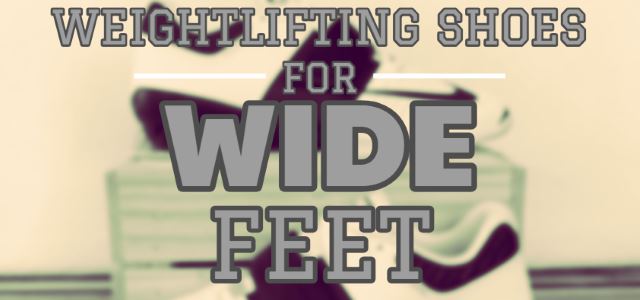
We understand the problem!
Weightlifting shoes can be a big investment. You want yours to be comfortable in the gym and badly fitting squat shoes can really mess up your workouts.
They can even cause you to lift less!
There is no shortage of options for weightlifting shoes on the market, but if you have wide feet it might be harder to find a shoe that fits you properly.
You’ve likely not found much guidance on which are the best weightlifting shoes for wide feet. So we are here to help!
Top 3 Best Weightlifting Shoes for Wide Feet
| Rating | Review | |||
|---|---|---|---|---|
| #1 |   | Nike Romaleos | Click For Nike Romaleos Price | Best overall. One of the best weightlifting shoes around and great for wide feet too! |
| #2 |   | Adidas Powerlift 3.1 | Click For Adidas Powerlift Price | A well respected shoe. Great value for money. |
| #3 |   | Reebok CrossFit Lifter 2.0 | Click For Reebok CrossFit Lifter Price | Great for cross-training and weightlifting |
To help you start your search for the best weight lifting shoes for wide feet we’ve compiled and reviewed the top performers here.
#1 – Nike Men’s Romaleos 3 Weightlifting Shoes
The upgraded version of the popular Romaleos 2, these are more of a hybrid lifting shoe instead of a traditional weightlifting shoe. They can be used for CrossFit exercises so you won’t have to worry about having two pairs of shoes for your workout of the day that may combine lifting and other exercises.
When it comes to the difference between the Romaleos 2 and the 3 one of the first things people notice is the single strap of the 3s instead of the two straps featured on their predecessor. This makes some lifters less sure about the upgrade since the decrease in the number of straps can mean that these aren’t as stable but reports say that the secure feeling is still there.
Another difference is the material. Nike added their Flywire material to make the Romaleos 3 more flexible since they’re a hybrid shoe and not a strict weightlifting shoe. Due to this change in material, the shoes are also quite lightweight weighing around 15 ounces with the hard-sole option and a lighter 13 ounces with the soft-sole option.
They weigh about 5 ounces less than an average weightlifting shoe.
An important factor in Olympic lifting shoes is heel height. The TPU heel measures at 0.79 inches which are slightly higher than the standard 0.75-inch raised heel height of other lifting shoes. This slight change provides a better range of motion and stability for squats, snatches, and clean and jerk moves. The TPU material is sturdy and resistant to abrasions and compression more than other materials.
Finally, when it comes to fit, these are very good for the wider foot.
If you have a wide foot, it’s recommended that you go to the store to try these on first to determine the best size for you. You can then shop around online for a better price.
There are some pros and cons worth considering before you settle on these shoes.
- Lightweight and comfortable
- Different insole options offer versatility
- Sturdy enough for lifting, flexible enough for mobility
- Wide range of colors to choose from
- Comparatively expensive
- Lighter material not as durable
#2 – Adidas Powerlift
These weightlifting shoes are considered a hybrid shoe since they can be used for weightlifting as well as other exercises. This makes them ideal for CrossFit or similar routines where you’ll be engaging in other workouts besides lifting. They are also featured in our guide to the best women’s weightlifting shoes.
The Powerlift 3.1 is lighter than other shoes which a lot of frequent lifters don’t really like but it’s actually ideal for people who are new to lifting and might not be able to adjust to the heavy, stiff traditional weightlifting shoes. They only weigh about 15 ounces so there is no real difference from normal cross trainers.
What makes this a lifting shoe is the heel height. It features a 0.6-inch EVA heel lift making it one of the lower lifting shoes but it’s still considered effective for low-bar squatting. While the standard 0.75-inch lift might be preferable to some lifters, this lower heel is better for people who are looking for something a little more versatile for their workouts. The material of the heel is more of a problem than the low heel. The EVA, while durable, isn’t as resistant to things like abrasions like TPU. It’s also not as rigid so it compresses more than TPU.
The rest of the shoe is made of breathable mesh and lightweight leather for a mix of breathability and stability. This makes them flexible, too. According to reviews, they are pretty comfortable right out of the box but takes about a week to fully break them in. While they might not feel as sturdy as other shoes the thick single strap secures your foot to provide more stability.
In terms of size, this shoe is wider than others to help accommodate people with larger feet, and the wide toe box if accommodating. There also seem to be some discrepancies in whether you should size up or down from your normal street size. In general, it seems like most users reported they fit as expected but a good chunk of people mentioned they’re slightly small so it might be worth buying a half size up.
To help you make a more informed purchase decision, consider some of these pros and cons determined by user reviews:
- Suitable for workouts other than lifting
- More comfortable than heavier shoes
Cons:
- Color options for women are limited
- Sole/heel not as durable as other shoes
#3 – Reebok CrossFit Lifter 2.0
While this is more of a CrossFit shoe it is considered a hybrid weightlifting shoe. It provides decent stability while still being flexible enough to be used for your other exercises. If you do CrossFit regularly and your workout of the day has weightlifting elements in it, these shoes can work well for you since they’re suitable for more than just lifting.
The Reebok CrossFit Lifter 2.0 features a 0.75-inch heel elevation for lifting and also features mesh and synthetic material to make the shoe more breathable than other weightlifting shoes. This can make the shoe a little more unstable than some lifters like but a single, strong metatarsal strap does provide some extra stability. As for the rubber sole, it has a large contact area to the floor so you can push your feet evenly into the floor as you lift.
In terms of the fit, this fits true to size and is considered to have a normal-sized width. According to user reviews, the fit is perfect even for those with slightly wider feet since the material on these has a little more give than other stiff weightlifting shoes. It comes is a range of colors making a great CrossFit shoe for women and men alike.
There are some pros and cons worth noting based on product reviews. Consider these before making a purchase decision.
- Multi-functional shoe saves you money
- 10 available colors to choose between
- Velcro on the strap can deteriorate easily
- Not considered suitable for competitive lifting
What Constitutes a Wide Foot?
If you have a wide foot you are probably well aware of what that means for you—your feet are wider than average and buying shoes can be annoying. However, shoe manufacturers look at wide feet differently so it’s important to understand what they mean when they say that certain shoes are for wide feet.
The width of your feet (according to manufacturers) is measured from the outside of your pinky toe to the most extreme part of the medial side of your foot. This might differ based on the shape of each individual foot but this is the measurement that is being listed on product descriptions. When shopping, compare your own foot’s measurement to that number to get an idea of how the shoe will fit you.
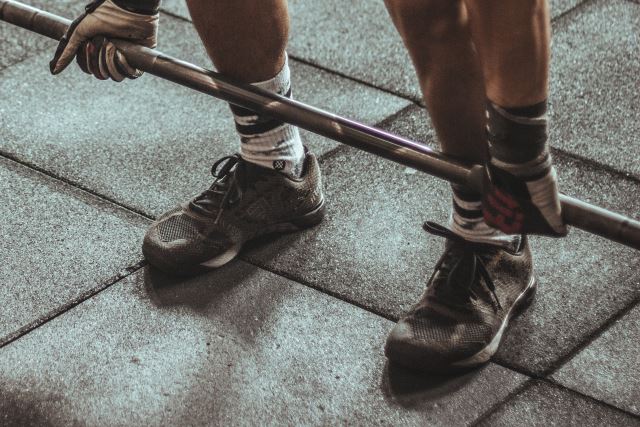
When it comes to trying on and buying weightlifting shoes for wide feet, consider the toe box as well as the shoe’s construction. These are the two aspects of these shoes that will determine how comfortable they are on your wider-than-average feet.
A Wide Toe Box
The toe box is the front portion of the shoe that stretches from the end of the laces to the tip of the shoes. When it comes to lifting, this part of the shoe is actually quite important since your feet need to maintain contact with the floor at three points: the pinky toe, your big toe, and your heel. This means that your toes need to have room to spread to maintain proper contact during all of your power moves. By having a shoe with a wide toe box you can know that your toes will have plenty of room to splay out at you push them into the floor. If your shoes are too narrow to do this properly you risk injuring yourself because of your bad form.
As for the construction of the shoe, you need to make sure that the material is durable enough to last you a long time even with consistent use. Weightlifting shoes tend to be leather or a combination of leather and mesh making them a little more restrictive than cloth-based shoes. This means that they won’t stretch out as easily so you have to keep that in mind. If you get something too restrictive you can’t count on it stretching out anytime soon.
So, when you measure your foot and compare that to the measurements of the given shoe you will also have to take into account the material of the shoe around the toe box and the structure of the toe box itself. You mainly need to ensure that your toes have plenty of room to splay while still being properly confined.
The Benefits and Drawbacks of Wide Weightlifting Shoes
While it’s not “wrong” to lift weights while wearing your regular gym shoes, there are advantages that weightlifting shoes can give you that regular sneakers can’t. For example, weight lifting shoes feature an elevated heel made of sturdy material. This heel can give you a better range of motion in certain moves like squats. Other benefits are:
- Stronger ankle support
- Improved stability in power moves
- Secure fit from the metatarsal strap(s)
- Can help you lift more due to better form
While weightlifting shoes are great for lifting, there is one significant disadvantage. These shoes won’t typically serve any other function in the gym other than lifting. This means you’ll either be changing out of them to do other exercises or you’ll only wear them on lifting days.
Due to their usually expensive price tags, this might not seem like a worthy investment even considering the benefits. Many people actually lift barefoot rather than sneakers shoes but can bring about other health and safety issues.
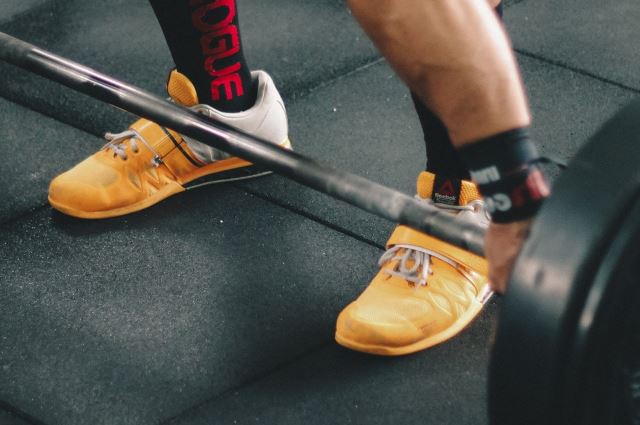
If you’re looking for a shoe to pull double duty in your workouts, you should look for a hybrid type of weightlifting shoe. These are shoes with elevated heels like standard weightlifting shoes but they tend to be a little more flexible and lighter. These distinctions make it possible to wear your weight lifting shoes for other exercises making them ideal for CrossFit where you’ll be switching between lifting exercises and more cardio-based workouts.
What to Look for When Buying Lifting Shoes For Wide Feet
In order to make sure that you’re getting the best possible weightlifting shoes that have everything you need them to have to function properly, there are certain things that you should look for when comparing products. By ensuring that the shoe you plan to buy has the right kind of features you can make a more informed purchase decision while making sure you’re getting the most out of your money.
Flat Soles
The best kinds of weightlifting shoes have flat soles, not a curved arch or gel-cushioned sole. While these features are great for running shoes they’re less than ideal for lifting. These types of shoes will compress too much under heavier weights and make you feel unstable which can lead to injuries. Flat soles will, instead, give you that secure stability to help you push into the floor confidently.
Heel Elevation
Another important consideration is the heel elevation of the shoe. Yes, you want a flat sole but a good weightlifting shoe will also incorporate an elevated heel (without an arch or cushion). While the average shoe will have a 0.75-inch elevation there are shoes that are as high as 1 inch while others are as low as 0.3 inches.
This elevation helps you squat deeper without leaning forward and hurting your back or losing your balance. It also helps you gain more mobility in your shins and ankles. Your improved posture and overall form while lifting are other benefits of the elevated heels. This improved form and stability can help you lift heavier weights, too.
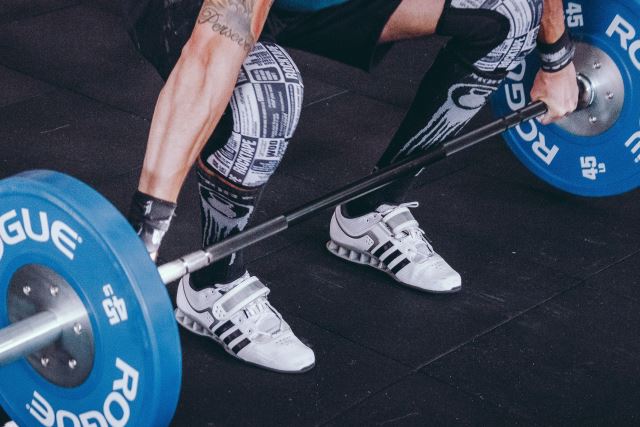
When buying weightlifting shoes, consider your torso length as well as how long your legs are. In general, people with long legs prefer higher elevated heels because it helps them improve their squats. Look at this distinction while you compare shoes to get the best one for your needs.
Straps
For better stability and a really secure fit look for weightlifting shoes with at least one strap that goes across your foot. This is known as a metatarsal strap. It’s there to provide you with more security than simple laces offer. These should be pulled as tight as possible so you lock your foot into place for your lifts. With these straps, your feet won’t slide inside your shoes as you work out which will protect your ankles.
As you look at shoes, look at the material the straps are made of and how they are sewn onto the shoe. You don’t want a strap that will fray or come apart in any way. Some are simply Velcro while others have loops and locks on them. They both work well so you can get what you prefer here without an issue.
Size and Comfort
You will also have to make sure that you find a weightlifting shoe that fits you properly and is comfortable enough to wear throughout a full workout. These kinds of shoes tend to be snug and rigid so they’re not as comfortable as other gym shoes. You don’t want them to pinch your toes or heels because if they’re too uncomfortable you won’t get through your workout. If you can, try on shoes in a store before making a purchase even if you plan to buy a pair online.
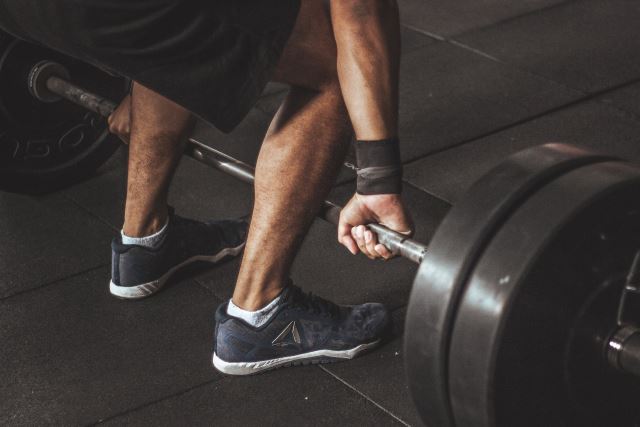
Your feet should feel supported and secure but not constricted to the point where you can’t move. You shouldn’t slide forward, backward, or side to side inside of the shoe. You shouldn’t feel like your ankles are going to turn either; they should be stable. Since you have wide feet, you have to remember to look at each shoe and see if their measurements fit your measurements. Remember, these will be snug but you should still be able to spread your toes in them properly.
Every shoe brand makes its shoes differently so you may find that some are narrower than others while another brand might be more rigid than the next. You have to find what feels right on your feet so your workouts won’t be hindered.
Durability and Material
Finally, look for weightlifting shoes that are made with durable material that won’t wear out under the pressures of frequent use. If you’re constantly lifting, your shoes will be in constant use. You don’t want them falling apart especially since they’re more expensive than normal gym shoes.
Look for shoes with a solid base made of strong plastic or even wood. These won’t compress easily under heavy weights so they’ll last longer than lower quality shoes. Similarly, look for straps that are attached securely and that won’t break under pressure. The laces on your shoes should also be tough enough to withstand constant use. In general, a good pair of weightlifting shoes should last you around two years even with frequent use.
Conclusion
Now that you know what to look for in the best weightlifting shoes for wide feet you can shop with confidence and make a sound investment in your fitness routine. Remember to always read user reviews to get a good idea of how the shoes are made and how they fit. If you can, get to a store and try on some options before making a purchase either in person or on the internet so you get the best fit; your feet will thank you.



No way I’m buying the Nike brand. You disrespect law enforcement and I’m not buying your stuff. Adidas it is. Thanks for the great review.
Stick to NewBalance than ya snowflake
Hi, I think this article is good about shoes. thanks.